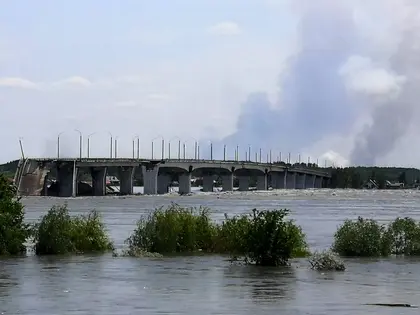In the early hours of Tuesday morning, an the Kakhovka Dam in Ukraine’s Kherson region collapsed, sparking an international blame game, mass evacuations and an unfolding ecological disaster.
Here are the seven critical things you need to know:
JOIN US ON TELEGRAM
Follow our coverage of the war on the @Kyivpost_official.
1. The dam
The Kakhovka hydroelectric dam is located on the Dnipro River upstream from the city of Kherson and downstream from the Russian-held Zaporizhzhia nuclear plant (ZNPP).
- Look at the latest Ukraine news that was released today.
- Receive the latest Ukraine news bulletins for today.
The dam held the Kakhovka reservoir in place, which can hold 18 cubic kilometers of water – approximately the same capacity as Utah's Great Salt Lake.
The Russian terrorist state has destroyed the dam at Nova Kakhovka.
— Michael MacKay (@mhmck) June 6, 2023
Massive flooding of the Dnipro River is underway, downstream to the city of Kherson.
This is a monstrous war crime. pic.twitter.com/7UO3CA4FQo
The 3.3-kilometer-long dam along with its hydroelectric power station was captured by Russian forces at the beginning of the full-scale invasion on February 24, 2022.
It’s strategically important for several reasons. Firstly, it is an important water source for the Russian-annexed Crimean Peninsula, pumping water into the North Crimean Canal, which starts in southern Ukraine and crosses the entire Crimean Peninsula.
Secondly, the ZNPP relies on the Kakhovka reservoir to supply the water used in its cooling systems.
Thirdly, and the full implications of this aren’t yet fully known, but the extensive flooding caused by its destruction could hinder Ukraine’s plans for its counteroffensive operations.
The Dnipro River marks the current frontline in the region with Russians in control of the left bank (south on a map) and the Ukrainians, the right bank. The city of Kherson itself was liberated by Ukraine last autumn.

‘Ukraine Doing Everything to Ensure 2025 Becomes a Year of Lasting Peace’ – Ukraine at War Update for Dec. 25
The Geneva Conventions prohibit attacks on dams unless "it is used for other than its normal function and in regular, significant and direct support of military operations and if such attack is the only feasible way to terminate such support," an exemption that did not apply to the Nova Kakhovk dam.
2. The blast
President Zelensky said on Tuesday afternoon that a blast destroyed the dam on June 6 at 2:50 am local time (23:50 GMT).
A press release from Ukrhydroenergo said the dam had been “completely destroyed,” adding: “The station cannot be restored.”
Video shot during the day showed a vast amount of water flowing through a huge hole in the dam.
A torrent of water burst through a gaping hole in a dam on the Dnipro River that separates Russian and Ukrainian forces in southern Ukraine, flooding a swathe of the war zone and forcing villagers to flee https://t.co/0oMMp8IlSH pic.twitter.com/Suj8eKYl3k
— Reuters (@Reuters) June 6, 2023
‘Before’ and ‘after’ satellite imagery released on Tuesday gave an even clearer picture of the scale of the damage.
First satellite images of the destroyed #Kakhovka Hydroelectric Power Plant
— KyivPost (@KyivPost) June 6, 2023
Its building is completely destroyed.
📷: @cxemu pic.twitter.com/G9nPmH8YP1
An estimate by Ukraine’s Emergency Situations Ministry said the water release could create a wave 4.8 meters high and 5 kilometers wide, moving at 24 kilometers an hour along a 90 kilometer stretch of river.
It's worth noting that the dam had previously suffered structural damage, as pointed out by NPR Science editor, Geoff Brumfiel.
3. The blame
Russia has claimed the dam was destroyed by "multiple strikes" carried out by Ukrainian forces, without providing any evidence.
Ukraine on the other hand, accused Russia of blowing up the dam and even named the specific Russian army unit it alleged was responsible for installing the demolition charges.
Oleksiy Danilov, an advisor to President Volodymyr Zelensky, said that Ukrainian military intelligence had identified Russia’s 205th Motor Rifle Brigade as the unit most likely to have installed explosives inside the dam.
Andriy Yusov, an Armed Forces of Ukraine (AFU) military intelligence spokesman, told Kyiv Post that Ukraine’s intelligence services had been tracking Russian activity at the dam and power station for more than a year, and that the Ukrainian government is sure Russian officials gave the order for explosive charges inside the station’s interior machine spaces to be detonated.
“Last year, Ukrainian military intelligence reported that the Kakhovka hydroelectric power station had been mined by Russian troops, publishing photographic and video evidence,” he said.
Natalia Humeniuk, spokeswoman for Ukraine’s Joint Forces South command, in comments to the UNIAN news agency and Radio Liberty, said that “there is no question” the dam was demolished by an internal blast or blasts and pointed to widely-available video and still images in the public domain which seem to show that the dam’s main structure had collapsed from the inside.
Extensive images showing the dam heavily damaged at or below the waterline are near-conclusive evidence Russia, not Ukraine, knocked the structure down, she said.
Ukraine said that Russia's goal was to “create obstacles” for Kyiv's counteroffensive to retake territory from Moscow's forces.
British PM Rishi Sunak said late Tuesday that Britain's military and intelligence agencies were probing whether Russia was responsible, but that it was "too soon" to make "a definitive judgement", a line echoed earlier in the day by the U.S.
4. The human cost
Evacuations of the affected areas began first thing on Tuesday morning. Currently there is no information on people killed or injured due to the flooding but on Tuesday evening, the White House said there will be "likely many deaths."
Veronika Trushina, 50, an entrepreneur who lives in the Ostrov district of Kherson, told Kyiv Post that she left her house first thing to go to her mother’s house on higher ground.
There is no electricity in her neighborhood and “houses in the area of River Port completely stand in water.”
Trushina also said Russian forces had been shelling the area throughout the day: “Not only are they flooding us, they also kill those who evacuate.”
Video from the Ostrov neighbourhood of Kherson.
— Chris York (@ChrisDYork) June 6, 2023
The woman who filmed it claims shelling by Russian forces in the area "has gone on all day."
"Not only are they flooding us, they also kill those who evacuate." pic.twitter.com/fqnVSD82rw
Ukraine's interior ministry said 17,000 people were being evacuated, with a total of 24 villages flooded.
Video posted to social media showed volunteers in boats looking for people to evacuate as Russian shells landed nearby.
📹 Volunteers rescue people in #Kherson Region right under the shelling by the Russian army pic.twitter.com/SVdTiL1B5X
— KyivPost (@KyivPost) June 6, 2023
Kyiv officials said there were a total of 16,000 people living in the "critical zone" for potential flooding.
Ukraine’s ministry of defense also warned of the danger posed by mines and other explosive objects displaced by the flood waters.
On the Russian-controlled left riverbank, Vladimir Leontyev, the Moscow-installed mayor of Nova Kakhovka where the dam is located, said the city was underwater and 900 people had been evacuated.
He said 53 evacuation buses were being sent by the authorities to take people from Nova Kakhovka and two other nearby settlements to safety.
"We are organizing temporary accommodation centers with hot meals," he said.
Nova Kakhovka in Kherson region right now: lower city part flooded, zoo, summer cinema, park area, stadiums. Street along the shore was flooded. Old part of city, 2- and and 3-story Finnish houses, including those that belong to architectural monuments, Radio Svoboda reported pic.twitter.com/5ePakh8NDl
— Margo Gontar 🔱 (@MargoGontar) June 6, 2023
5. The ecological cost
The full ecological impact of the destruction of the dam won’t be known for some time, but there is no doubt it will be immense.
Ukraine has already warned of a potential "ecocide" after 150 tonnes of engine oil spilled into the river, from the dam’s machinery, as a result of the attack.
Footage posted on social media showed a zoo in the region completely flooded with animals left wandering the streets.
People save animals on the outskirts of Kherson, but most of them will die.
— Victoria Amelina 🇺🇦 (@vamelina) June 6, 2023
Blowing up the Kakhovka dam is a crime. In fact, we should start saying it loudly:
Russia is committing #ecocide. pic.twitter.com/JIcBXI3kdC
READ MORE: Kakhovka Flood Hits Animals Too, Zoo Washed Out, Beavers Walk Village Streets
6. The nuclear risk
Given the nearby ZNPP, there were initial fears of the explosion sparking a nuclear incident but Ukraine's energy operator Energoatom was quick to clarify the situation at the nuclear power plant was under control. The UN's nuclear watchdog also said on Tuesday it saw “no immediate nuclear safety risk” at the plant.
Victoria Voytsitska, former Secretary of the Committee on Fuel-Energy, Nuclear Policies and Security in the Ukrainian Parliament, told Kyiv Post: "In order for the Zaporizhzhia nuclear power plant to operate safely, it requires a certain volume of water to carry out essential cooling processes for its units.
“Water from the Dnipro River is indeed used for this purpose, which is stored in water pools located near the station itself."
Voytsitska said that the ZNPP's current water pools are filled to capacity, ensuring a sufficient water supply to the station for an extended period.
"There is ample water there for a long time to provide the station with water," she said.
Longer term however, there could be complications. If the supply of water runs low due to evaporation in a heat wave or an inability to fix the dam, the most obvious solution would be to bring in mobile pumping stations to supply the plant.
But currently, the bank of the river where these pumps would be stationed are mined meaning Russian forces would have to demine the area first.
READ MORE: Zaporizhzhia Nuclear Power Plant Safe Despite Dam Explosion, Former Ukrainian Official Assures
7. The response
President Zelensky on Tuesday said the "world must react" to the Kakhovka dam attack, adding: "This is just one Russian act of terrorism. This is just one Russian war crime.”
“Russia is at war with life, with nature, with civilization. Russia must leave Ukrainian land and must be held fully accountable for its terror.”
EU chief Charles Michel on Tuesday expressed shock at the attack on Ukraine's Nova Kakhovka dam and pledged to hold Russia accountable for the "war crime" of destroying civilian infrastructure.
"Shocked by the unprecedented attack of the Nova Kakhovka dam. The destruction of civilian infrastructure clearly qualifies as a war crime – and we will hold Russia and its proxies accountable," he wrote on social media.
NATO chief Jens Stoltenberg said the dam breach was "outrageous" and "puts thousands of civilians at risk and causes severe environmental damage."
United Nations Secretary-General Antonio Guterres said Tuesday the disaster was "another devastating consequence" of Russia's invasion of its neighbor.
"Today's tragedy is yet another example of the horrific price of war on people," Guterres told reporters at UN headquarters in New York.
"The floodgates of suffering have been overflowing for more than a year. That must stop," he added.
The UN Security Council held an emergency meeting on Tuesday following requests from Russia and Ukraine.
"Today's news means the plight of the people in Ukraine is set to get even worse," the UN's top humanitarian official Martin Griffiths told the meeting.
You can also highlight the text and press Ctrl + Enter









